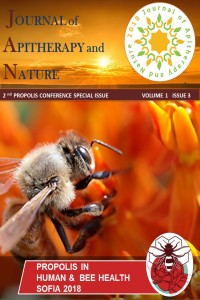Application of Natural Deep Eutectic Solvents for Green Extraction of Bioactive Compounds from Poplar Propolis: A Preliminary Study
Öz
At present one of
the key issues in the chemistry field is the development of so called
"green" technologies that aims to preserve the environment and to
reduce the negative influence of human involvement. Among the diverse ways of
“green” technology, developing and applying “green” solvents are one of the
most important subjects. Recently, a new type of “green” solvents, named deep
eutectic solvents (DESs), was developed. DES is a mixture of proton acceptor
and a proton donor in solid state, which are joined by intermolecular
hydrogen bonds. The resulting mixture is eutectic, i.e. it has a lower
melting point than that of any of its individual components and it is liquid
even at very low temperatures. In a particular combination and ratio natural
compounds in solid state (primary metabolites) may also be converted into
liquids to form so called natural deep eutectic solvents (NADESs), which are
present in nature. They are biocompatible and play a role in all kinds of
cellular processes of living organisms.
NADESs have
several advantages as solvents: easy and inexpensive preparation,
biodegradability and in addition, the precursors used for their production
are natural, non-toxic, renewable compounds, which are abundant in our daily
foods. It was found that NADESs have a number of interesting applications in
electrochemistry, functional materials, organic synthesis, catalytic
transformations and pretreatment processes. Recently, the interest in NADESs
increases due to their successful application in the extraction of bioactive
plant metabolites, including non-water soluble. Besides, the extracted
compounds can be easily recovered from NADES. This predicts a great potential
for NADESs as solvents in the extraction processes of valuable secondary
metabolites, further implemented in the food or pharmaceutical industry.
Still the most
effective and widely used way for exhaustively extraction of all biologically
active components from poplar type propolis, is extraction with 70% ethanol
in water. The use of alcohol, however, limits the application of propolis as
it is contraindicated in a number of diseases, in young children and pregnant
women. In order to protect both human health and the environment it is
necessary to seek alternative ways of extraction of this valuable
biologically active complex. Therefore the present study aims to apply for
the first time a new approach for extraction of biologically active compounds
from poplar type propolis based on the use of NADESs and to evaluate their
extraction efficiency.
Acknowledgment: The financial support of the National
Science Fund of Bulgaria, project DN19/4, is gratefully acknowledged.
Anahtar Kelimeler
Natural deep eutectic solvents Deep eutectic solvents Propolis
Kaynakça
- .
Öz
Kaynakça
- .
Ayrıntılar
| Birincil Dil | İngilizce |
|---|---|
| Konular | Mühendislik |
| Bölüm | 2nd Propolis Conference Special Issue |
| Yazarlar | |
| Yayımlanma Tarihi | 8 Aralık 2018 |
| Yayımlandığı Sayı | Yıl 2018 Cilt: 1 Sayı: 3 - 2nd Propolis Conference Special Issue |
Kaynak Göster
ASOS Index

